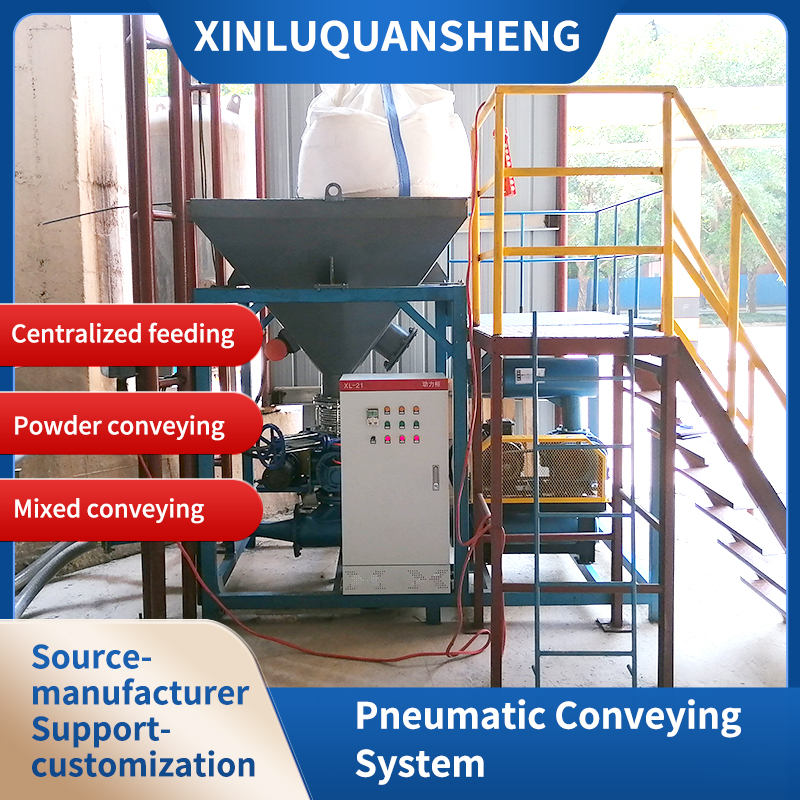 濟南鑫魯泉盛機械設備有限公司
濟南鑫魯泉盛機械設備有限公司
服務熱線:15662735099
聯系地址:山東章丘棗園經濟開發區
旋轉供料器的氣路系統是保障其與氣力輸送系統協同運行的核心,通過合理的氣壓控制與氣流分配,實現物料密封輸送與設備保護,其設計是否合理直接影響供料精度、能耗及運行穩定性。氣路系統需兼顧密封、吹掃、輔助動力等多重功能,與機械結構形成聯動,確保物料在輸送過程中不泄漏、不堵塞。
The pneumatic system of the rotary feeder is the core to ensure its coordinated operation with the pneumatic conveying system. Through reasonable air pressure control and airflow distribution, material sealing conveying and equipment protection are achieved. The rationality of its design directly affects the feeding accuracy, energy consumption, and operational stability. The pneumatic system needs to take into account multiple functions such as sealing, blowing, and auxiliary power, and form a linkage with the mechanical structure to ensure that materials do not leak or block during transportation.
氣路系統的核心構成包括氣源裝置、控制元件與氣路接口三部分。氣源通常來自壓縮空氣站,經干燥過濾后通過主管道輸送至供料器,壓力一般控制在穩定范圍以滿足不同工況需求。控制元件包含電磁閥、壓力調節閥、壓力表等,電磁閥負責氣路的通斷控制,可與供料器葉輪轉動形成聯動(如葉輪每轉動一周觸發一次補氣);壓力調節閥用于精確控制各氣路分支的壓力,如密封氣壓力需略高于輸送管道壓力以防物料反竄。氣路接口分布在供料器殼體的關鍵位置:密封氣接口多位于葉輪兩端的軸封處,形成氣幕阻隔物料進入軸承;吹掃氣接口正對葉輪間隙與殼體死角,用于清除殘留物料;補氣接口則連接至出料口,輔助物料進入輸送管道。
The core components of the pneumatic system include the gas source device, control components, and pneumatic interface. The gas source usually comes from a compressed air station, which is dried and filtered before being transported to the feeder through the main pipeline. The pressure is generally controlled within a stable range to meet the requirements of different working conditions. The control components include solenoid valves, pressure regulating valves, pressure gauges, etc. The solenoid valves are responsible for controlling the on/off of the air circuit and can be linked with the rotation of the feeder impeller (such as triggering air supply once every rotation of the impeller); Pressure regulating valves are used to precisely control the pressure of each branch of the gas path. For example, the sealing gas pressure needs to be slightly higher than the pressure of the conveying pipeline to prevent material backflow. The air interface is distributed at key positions of the feeder housing: the sealing air interface is mostly located at the shaft seal at both ends of the impeller, forming an air curtain to block the material from entering the bearing; The blowing air interface is facing the clearance between the impeller and the dead corner of the shell, used to remove residual materials; The air supply interface is connected to the discharge port, and auxiliary materials enter the conveying pipeline.

氣路的密封功能是防止物料泄漏與環境污染的關鍵。軸封處的氣路通過持續通入低壓氣體,在葉輪軸與殼體之間形成環形氣幕,既阻止粉體物料滲入軸承腔造成磨損,又避免外界空氣未經處理進入輸送系統破壞壓力平衡。密封氣壓力需根據輸送物料的特性調整:對于超細粉體,壓力需略高于殼體內壓力以防粉塵穿透;對于粗顆粒物料,壓力可適當降低以減少能耗。當密封氣壓力異常下降時(如管道堵塞或氣源中斷),系統會觸發報警,提示操作人員檢查氣路,防止物料泄漏引發設備故障。
The sealing function of the gas path is the key to preventing material leakage and environmental pollution. The air path at the shaft seal is continuously filled with low-pressure gas, forming an annular air curtain between the impeller shaft and the housing. This not only prevents powder materials from penetrating into the bearing chamber and causing wear, but also prevents untreated external air from entering the conveying system and disrupting pressure balance. The sealing pressure should be adjusted according to the characteristics of the conveyed material: for ultrafine powders, the pressure should be slightly higher than the pressure inside the shell to prevent dust penetration; For coarse particulate materials, the pressure can be appropriately reduced to reduce energy consumption. When the sealing gas pressure drops abnormally (such as pipeline blockage or gas source interruption), the system will trigger an alarm, prompting the operator to check the gas path to prevent material leakage from causing equipment failure.
吹掃氣路的作用是清理設備內部殘留物料,避免結塊堵塞。在葉輪轉動間隙,吹掃氣通過定向噴嘴對葉片間的物料殘留進行吹掃,尤其針對吸濕性強或粘性大的物料,可防止其黏附在殼體內壁形成積料。吹掃氣的開啟時機與供料器運行狀態聯動:正常輸送時間歇吹掃(如每 10 分鐘一次),停機前則進行一次全面吹掃,確保內部無物料殘留。吹掃氣的壓力需適中,過高可能導致物料反沖至料倉,過低則無法有效清除殘留,實際應用中需結合物料流動性反復調試。
The function of blowing the air path is to clean the residual materials inside the equipment and avoid clumping and blockage. During the rotation clearance of the impeller, the blowing air passes through the directional nozzle to blow away the material residue between the blades, especially for materials with strong moisture absorption or high viscosity, which can prevent them from adhering to the inner wall of the shell and forming material deposits. The timing of opening the blowing gas is linked to the operation status of the feeder: during normal conveying time, intermittent blowing is carried out (such as every 10 minutes), and before stopping, a comprehensive blowing is carried out to ensure that there is no material residue inside. The pressure of the blowing gas should be moderate. If it is too high, it may cause the material to recoil into the silo, while if it is too low, it cannot effectively remove the residue. In practical applications, it needs to be repeatedly adjusted based on the fluidity of the material.
補氣氣路能輔助改善物料輸送條件,提升系統穩定性。當輸送管道內出現壓力波動時,補氣氣路可向出料口補充適量氣體,平衡管道與供料器出口的壓力差,避免因壓力驟降導致物料堆積。對于比重較大或流動性差的物料,補氣能增強氣流攜帶能力,防止在出口處形成搭橋堵塞。補氣量需與物料輸送量匹配,可通過流量計監測并調節,通常補氣量為輸送風量的一定比例,既能滿足輔助輸送需求,又不會過度稀釋物料濃度。
The air supply circuit can assist in improving material conveying conditions and enhancing system stability. When there is pressure fluctuation in the conveying pipeline, the supplementary gas path can supplement an appropriate amount of gas to the discharge port, balance the pressure difference between the pipeline and the feeder outlet, and avoid material accumulation caused by sudden pressure drops. For materials with high specific gravity or poor fluidity, supplementing air can enhance the carrying capacity of the airflow and prevent the formation of bridging blockages at the outlet. The amount of air supply should match the amount of material conveyed, which can be monitored and adjusted through a flow meter. Usually, the amount of air supply is a certain proportion of the conveying air volume, which can meet the needs of auxiliary conveying without excessively diluting the material concentration.
氣路系統常見問題多與壓力失衡、雜質堵塞相關。壓力不穩定會導致密封失效或吹掃不徹底,多因氣源壓力波動、調節閥失靈或管道泄漏引起,需定期檢查氣源壓力曲線,校準調節閥精度,對管道接口進行氣密性測試(如涂抹肥皂水觀察是否冒泡)。氣路堵塞多因壓縮空氣中的水分、油污未徹底過濾,在低溫環境下凝結成冰或黏附在閥門口徑處,可通過加裝高效過濾器(如精密濾芯)、定期排水排油解決,同時在寒冷地區對氣路管道進行保溫,防止凍堵。
Common problems in pneumatic systems are often related to pressure imbalance and impurity blockage. Unstable pressure can lead to seal failure or incomplete blowing, often caused by fluctuations in gas source pressure, malfunctioning regulating valves, or pipeline leaks. It is necessary to regularly check the gas source pressure curve, calibrate the accuracy of the regulating valve, and conduct air tightness tests on pipeline interfaces (such as applying soapy water to observe for bubbles). Air path blockage is often caused by incomplete filtration of moisture and oil in compressed air, which condenses into ice or adheres to the valve diameter in low temperature environments. It can be solved by installing high-efficiency filters (such as precision filter cartridges), regularly draining water and oil, and maintaining temperature in the air path pipeline in cold areas to prevent freezing and blockage.
本文由旋轉供料器友情奉獻.更多有關的知識請點擊:http://www.tourongquan.cn/我們將會對您提出的疑問進行詳細的解答,歡迎您登錄網站留言.
This article is dedicated to friendship For more information, please click: We will provide detailed answers to your questions. You are welcome to log in to our website and leave a message
2024 濟南鑫魯泉盛機械設備有限公司 備案號:魯ICP備18012408號-3 魯公網安備37018102000806號

